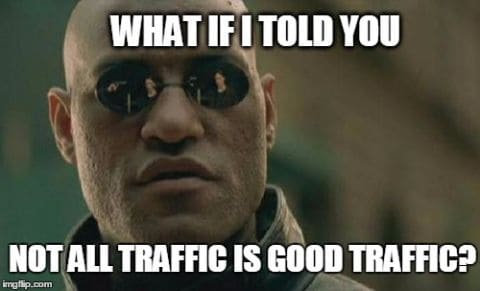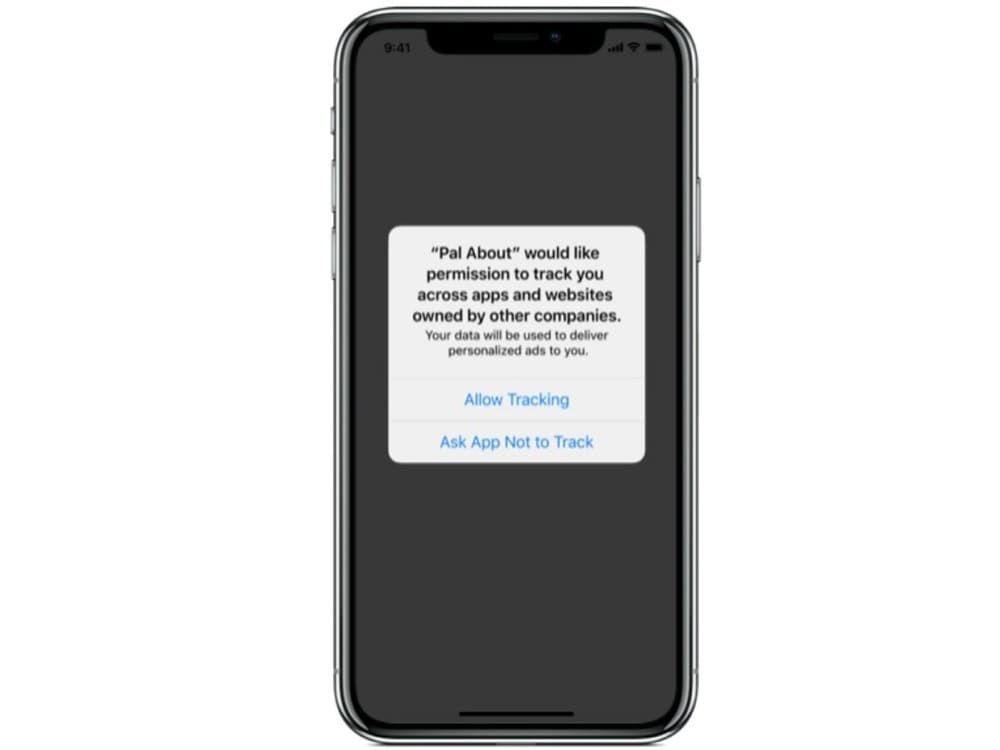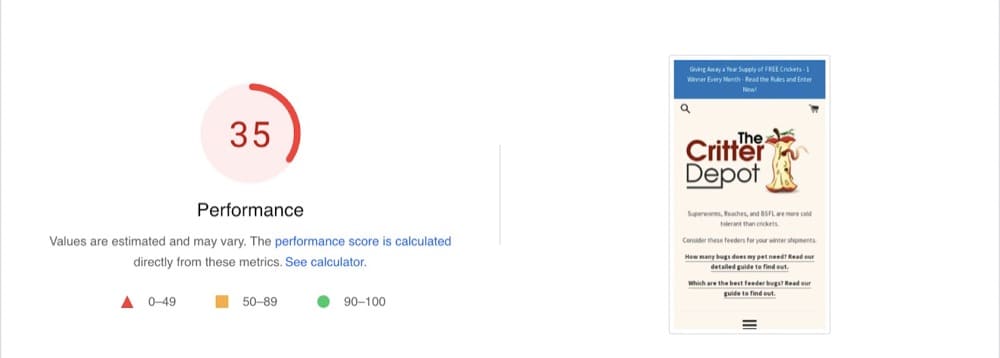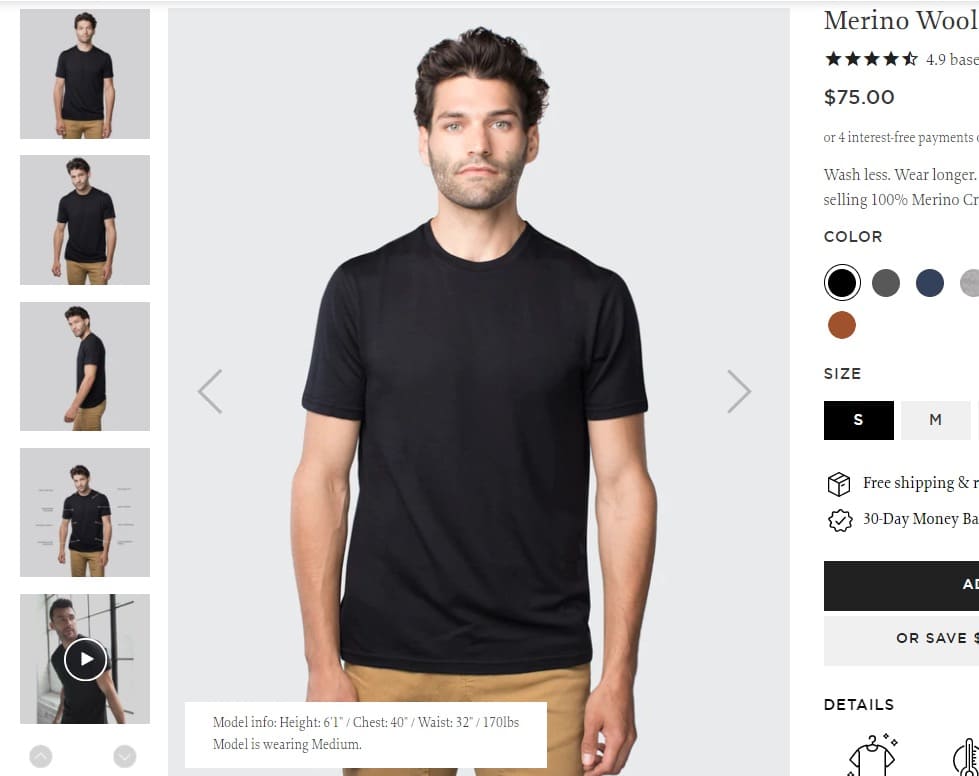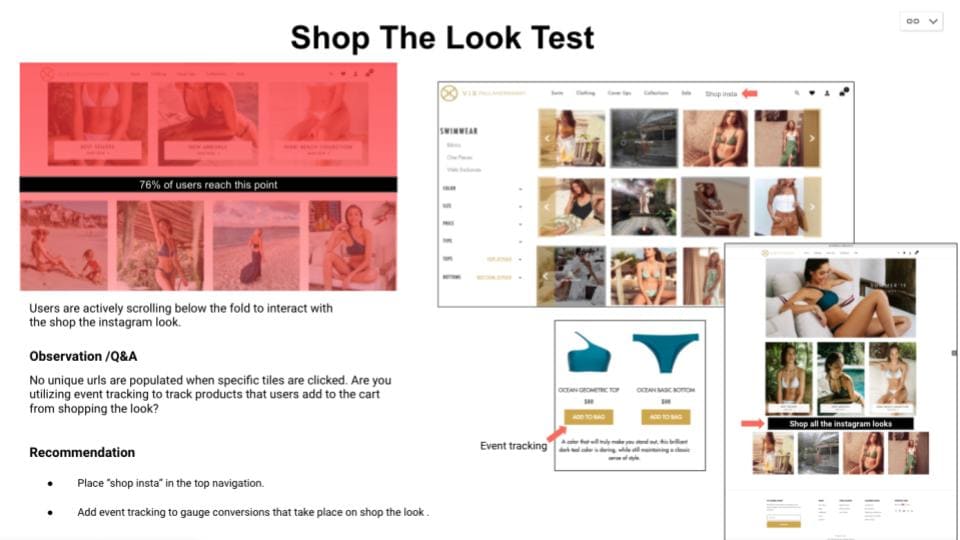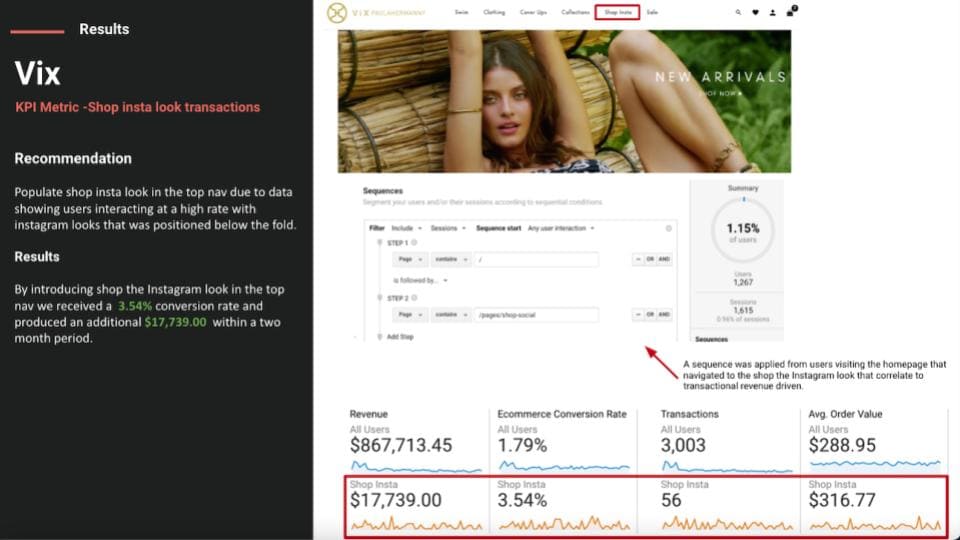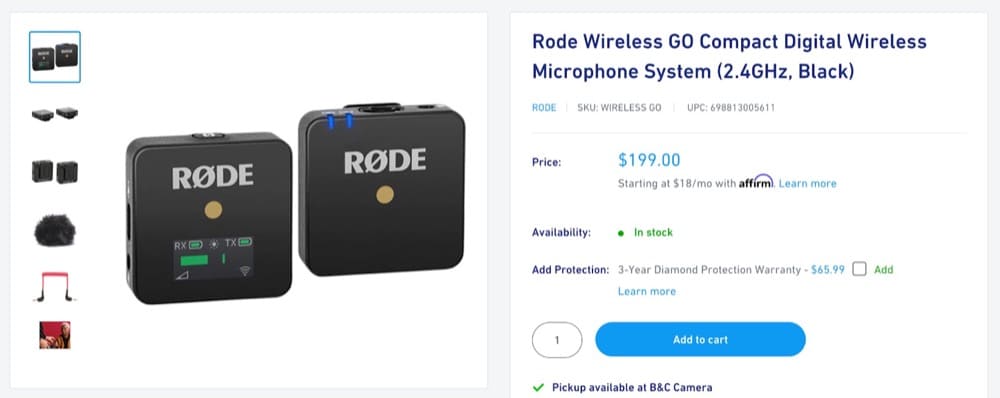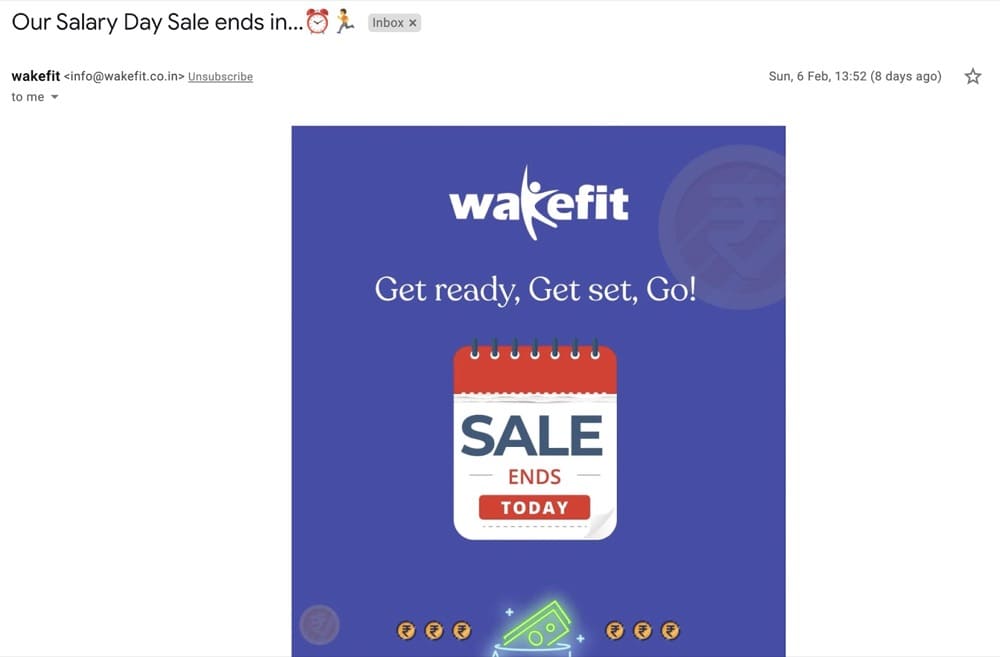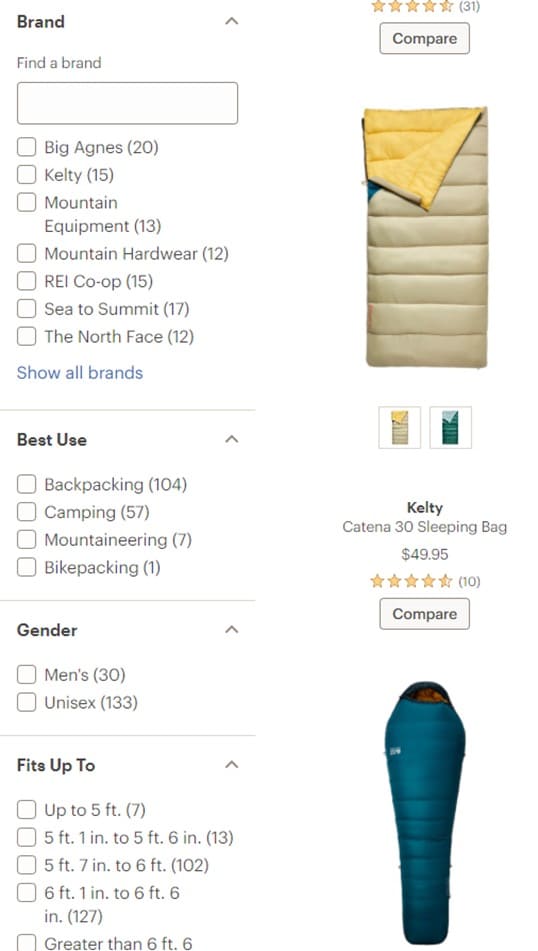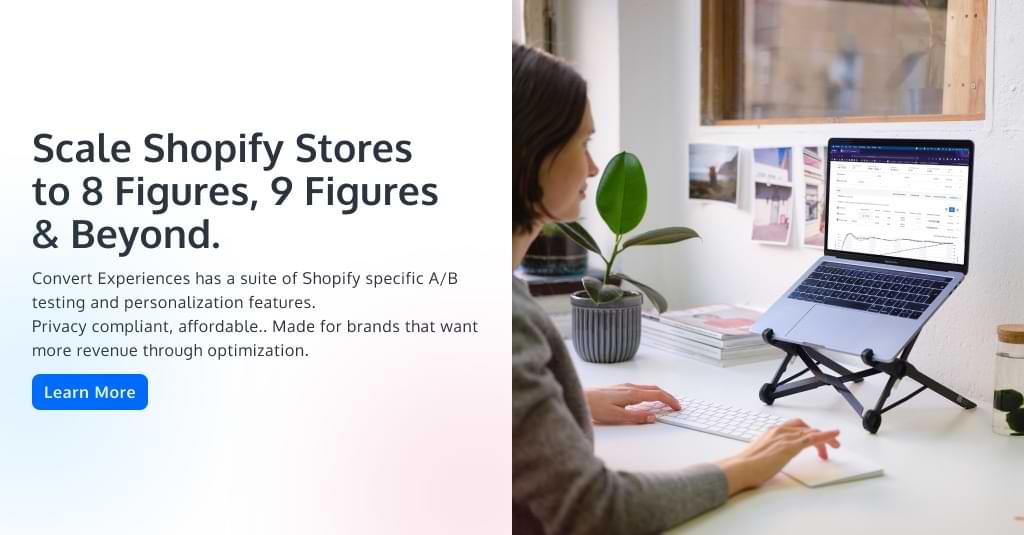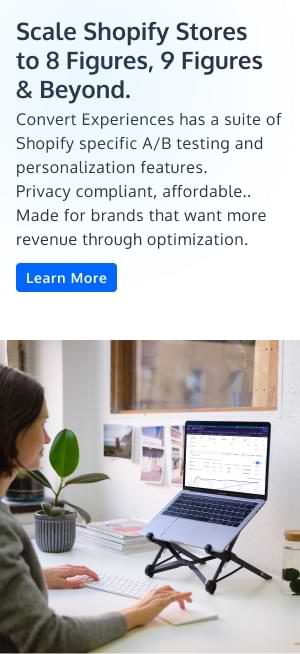How to Optimize Your E-commerce Site for Revenue
More traffic = more revenue, right?
If only it worked like that. It will be a tough pill to swallow, but all traffic isn’t good traffic.
You have a lot of window shoppers browsing, making comparisons, soaking in your content, but they’re just not ready to buy.
But that’s fine. You’ve probably poured gasoline on running ads instead. Because at least you know you’re getting in front of the right people.
Um yeah, that’s not happening either. In the post iOS 14 world, consumers are blatantly telling brands to stop data collection. According to this 2021 report from AppsFlyer, 62% of users opted out of tracking.
You could still use creative automation to crank out ads that get you a positive ROAS but that only leads to short-term wins when you really should be focused on revenue optimization.
What is Revenue Optimization in E-commerce?
Revenue optimization is managing acquisition, expansion, retention, and pricing strategies to boost long-term revenue growth.
But this all-encompassing definition hasn’t prevented an all-out war between these two camps—revenue optimization/generation and conversion rate optimization (CRO).
Joe Yakuel, Founder & CEO of WITHIN, a performance branding company, knows the reason.
This war is ongoing because we tend to focus on marketing efforts that drive immediate results while avoiding bigger ROI opportunities because results aren’t immediate.
While revenue optimization should ideally focus on increasing customer lifetime value, marketers are throwing money at ads to increase the topline. And based on your business objectives, this might make sense. If you’re looking to get funded soon, you may not want to invest in CRO or A/B testing simply because results take time.
But when you enter the next stage of your growth, your overreliance on ads will become a problem. Yakuel explains,
For a 20% improvement in revenue performance, you’d need to double your paid media investment. You could get a 20% lift in revenue running conversion or site speed improvements at a fraction of the paid media cost.
The 4 pillars of E-commerce Profitability
In e-commerce, profitability rests on 4 pillars:
- Supply Chain Optimization
- IT Modernization and Big Data
- Pricing and Revenue Management
- Customer Acquisition and Retention
Supply Chain Optimization
E-commerce fulfillment costs have always been higher, but in the wake of the pandemic induced supply chain disruption, rising costs are eating into profit margins. The economics around e-commerce are changing, and rising demand has brands struggling to fulfill them.
Brendan Sullivan, IATA’s head of e-commerce and cargo operations, shared in a webinar:
Approximately one in three customer transactions resulted in an out of stock or out of stock like experience which has resulted in up to $1trn loss for the e-commerce industry.
The answer lies in diversifying supply chains, switching to local suppliers, and using air-freight. Since this results in a higher production cost, 80% of companies in the US are passing on rising costs to consumers.
But this is a bad long-term strategy given how an NRF study found that 75% of consumers expect free delivery even on products under $50.
IT Modernization and Big Data
The intelligent answer to solving your supply chain optimization problems is investing in IT and big data.
You can use big data to optimize inventory costs via demand forecasting and inventory predictions or use cognitive order management to calculate optimal shipping rates or offer BOPIS (buy online pick up in store) to customers.
Modern IT infrastructure also means your warehouse can be digitized to rely more on robotic processing automation (RPA) instead of humans.
Apart from resolving back-end issues, AI and ML can create the perfect storefront. Offer live chat, product recommendations, and personalization based on user data.
P.S. If you haven’t already checked out Google Analytics 4, you’re missing out on some future-proof revenue optimization features that will serve you well even after Google phases out third-party cookies.
Pricing & Revenue Management
Amazon can get away with selling millions of products because it’s a marketplace, but you can’t. Take a look at your product offering and set a minimum order quantity (Amazon sellers do this too!), value, or cull the products with a razor-thin margin.
You can also increase your profitability by integrating price optimization strategies. You don’t have to take a haircut just because your competition is having a 70% off sale daily or price your products too low. Try dynamic pricing instead based on demand, audience groups, and time.
Customer Acquisition and Retention
Low CAC (customer acquisition cost) and high retention is the ultimate dream for all businesses. But getting there isn’t easy.
Understand the unique motivators aka why do people buy and use tech to make it easy for visitors to turn into customers.
Offer AI-enabled product recommendations, try customer behavior modeling, and use big data for personalization. But this doesn’t mean you don’t need the human touch.
You still need to be in the trenches with your customer and over-deliver. That may look like live customer service, making returns easy, or rewarding your most loyal shoppers.
We’ll dive into the exact strategies in a bit but remember to embrace the combination of human + machine to crack those metrics.
The Classic Revenue Optimization Mistake
You may not need any convincing that you should make revenue optimization a priority.
After all, you’re here!
But you may be on the verge of making a textbook mistake—optimizing for your north star metric (usually because it’s the easiest to improve) and leaving the rest in the dust.
When we reached out to e-commerce experts and read what had been published and shared widely, we realized that people view revenue optimization as a way to get customers to buy NOW.
So you’ll often be told to increase your site’s speed or optimize for mobile or improve the checkout process. All of those strategies are legitimate but are focused on customers further along in their journey.
You may make money through other revenue streams, but by only focusing on one, you’re leaving money on the table.
Say you’re in the hotel industry and your main revenue stream is room bookings, so you might be tempted to prompt that CTA to all your visitors. But what about those looking to use the spa, the golf course, or trying to book your venue for their wedding?
You’re mindlessly pushing the wrong CTA onto them.
Johnny Longden, Conversion Director at Journey Further, shares how you can overcome this problem.
The way to get around this is to ensure that you have revenue proxies for everything that matters on the website. So in the case of the hotel website, the online booking transaction is measuring bookings and rooms revenue, but you should also have a goal and a revenue proxy for any other inquiries. I might know that a conference inquiry will eventually convert 4%, resulting in a booking of an average of £20,000. I can then reverse engineer that back to understand the value of a single [phone] inquiry
Jeff Neal, the founder of Critter Depot, a site that sells live crickets and roaches to reptile pet owners, made a content strategy pivot to boost their conversion rate.
When we started, our content focused on the health benefits of crickets. But it attracted people who already knew they wanted crickets as feeders for the reptiles. Then, we started writing care guides for popular reptiles like bearded dragons and leopard geckos. These care guides brought in a whole new group of people that were unaware they could buy crickets online.
This led to a very low 36% bounce rate and a whopping 10% e-commerce conversion rate.
You can use your content to attract and nudge potential shoppers too. Calculate the visitor to customer conversion rate and transaction value to create a revenue proxy for your content marketing initiatives.
Putting all those revenue goals together and the revenue generated with transactional booking gives you a holistic view of your revenue optimization success.
10 Solid Ways to Optimize an E-commerce Site for Revenue in 2022
While CRO focuses on increasing the conversion rate at a particular touchpoint and the numbers wildly differ based on the goal, let’s take a look at visitor-to-customer conversion rate benchmarks for a minute.
According to Kibo’s E-commerce Quarterly, the Q3 2020 conversion rates in the US hovered around 2.7%. These numbers picked up in the last quarter, given the holiday season. So if your CRV (conversion rate) is below 2%, you’re likely in the red.
However, obsessing over benchmarks is unhealthy because CRO is not about that. It’s about understanding what your users want and delivering it to them.
As you’ll soon discover when we dive into strategies and results from brands, blanket advice doesn’t work.
Speed Up Your Load Times
All the experts we reached out to unanimously agreed that a slow loading site is probably hurting your revenue. Almost 70% of consumers surveyed by Unbounce report that page speed is a factor in their purchase decision. On average, website conversion rates plummet by 2.11% with each additional second of load time.
In 2022, fast sites are non-negotiable.
Without a fast site, it’ll be challenging to keep new customers on your site—let alone have them convert. In our report on Direct-to-Consumer Buying, we found 54% of respondents said encountering slow load times when shopping directly from a brand’s website makes them not want to shop there anymore.
Katilyn Ambrose, Content Marketer at Shogun
eCommerce stores are kinda slow by default, due to the sheer volume of pages and products. So you want to invest in a next-gen caching solution, a speedy hosting environment, and a robust CDN. Try to get your store and pages to load in under 3 seconds. You can use tools like GTmetrix and Google Pagespeed Insight to check your performance before and after implementing these changes.
Janis Thies, Managing Partner at SEOlutions.
Site speed is also an essential factor if you want to rank on Google. Faster site speed correlates to better rankings. But you don’t need to go into a frenzy trying to hit a 100.
CritterDepot was estimated to bring in $270,000 in 2019, and on mobile, the site scores a low 35.
So consider headless commerce instead.
Ambrose from Shogun shares,
With a headless store, the backend and the frontend work independently of each other and communicate via APIs (Application Programmer Interfaces). Headless storefronts see dramatic improvements to site speed and customer experience with no technical changes to inventory, subscriptions, checkout, and payments.
Overhaul Your Product Pages
Most product pages are just awful.
But let’s back up a bit.
If you’ve optimized your product pages to be more discoverable on search, congratulations! Using keywords to improve on-page SEO, breadcrumbs, and schema markups help.
But did you get stuck on the keywords you started with?
Daniel Tejada, Co-Founder of Straight Up Growth, explains why that’s a terrible idea.
Ever-changing consumer behavior also means our language is evolving. The search terms potential customers use to find the solution to their needs are also changing. Keywords are an essential aspect of SEO. And if the last time you did keyword research was a few years ago, your business may not be showing up in search results. It’s crucial to update your keywords annually.
Integrating search data makes it easier for shoppers to find you. Sep Niakan, Managing Broker at Condoblackbook recommends keeping an eye on your most popular pages and using buyer search behavior to optimize your product page.
So what about the actual page? Here’s what experts have to say:
- Show user reviews. But don’t leave out the negative ones. “100% positive reviews will always appear suspect,” says Oliver Andrews, Founder of OA Design Services.
- Use case studies. Jas Banwait Gill, Growth Manager of SnackMagic, shares, “Case studies helped us scale our business from 0 to $20 million in annual revenue in 8 months.”
- Don’t skimp on images. Customers can’t get a feel for your products without high-quality product photos. Martin Seeley, CEO of MattressNextDay, explains a lack of multiple images confuses the buyer leading to high bounce rates.
- Ditch the jargon. Ouriel Lemmel, CEO & Founder of Winit, explains that consumers don’t need to hear all the detailed specs of your product or service. “They care about how it will benefit them.”
While this advice is universal, you can find what your customers want through consumer surveys, heatmaps, visitor replays, and refine your hypothesis.
Striking off the original price and showing the discounted price may not make sense for you unless you’re a rebate marketplace like RebateKey.
Ian Sells, CEO & Co-founder, shares how a layout change boosted their sales by 10-15% for deals with discounts 30% and above.
Our product pages show items with their original and discounted prices, as well as the discount slashed off per product. One small change we did for our product page was to emphasize the discount by increasing the button size and font size, to emphasize how much discount the person saves for an item.
According to CRO expert Rich Page, discovering high-impact e-commerce improvement ideas starts with conversion research.
Rich created a customer survey for UnboundMerino and found that a common issue was shoppers weren’t sure which size to order.
To help make sure that visitors didn’t have this same problem (and risk leaving without buying), I got them to add model info just below the product image. This helped visitors get a better idea of sizing, and quickly increased conversion rate and revenue for that product.
Check our interview with Rich for more advanced conversion research tips.
Get Your Pricing Right
Your pricing strategy directly determines your profitability. We’ve already touched upon dynamic pricing, but you have to understand price elasticity before you try that. This helps you figure out how your customers will respond to fluctuations.
Price elasticity = (percent change in quantity demanded) / (percent change in price)
If price elasticity is <1, it means higher prices won’t dissuade customers from making a purchase.
On the other hand, if elasticity is >1, minor tweaks could impact your demand. So you could lower prices and increase your inventory to optimize revenue.
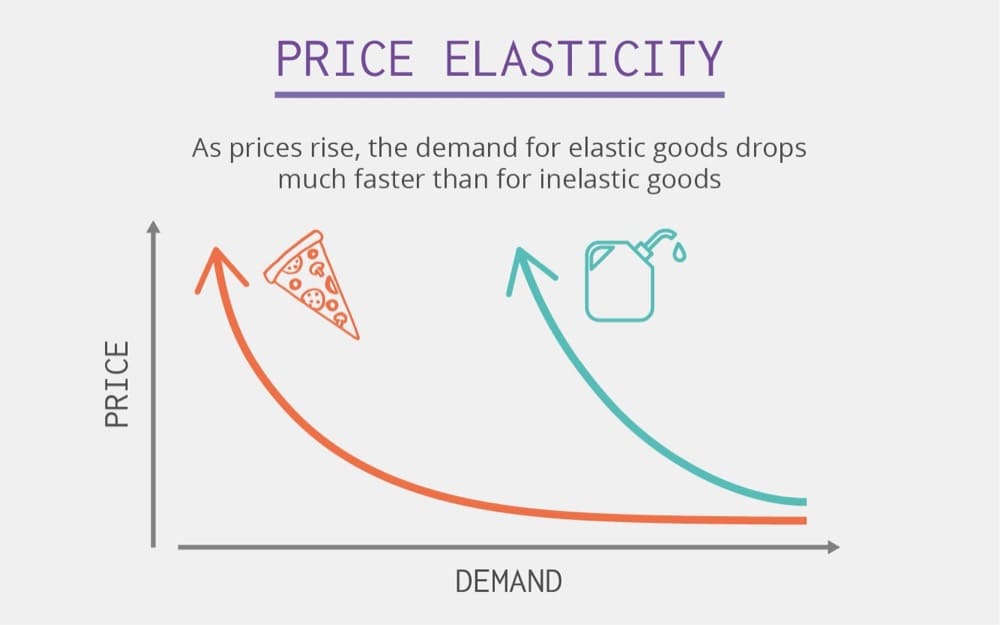
Bram Jansen, Chief Editor of vpnAlert, shares,
Your pricing strategy is determined by the revenue-generating model you employ. Some businesses opt for a low-cost pricing strategy in the hopes of growing volume. On the other hand, other models aim for a high price while focusing less on volume.
Let’s take a look at some different strategies you could try:
- Value-based pricing – For SaaS businesses like Hubstaff, you could price your features according to the product’s inherent value, differentiated features, and customers’ WTP (willingness to pay).
- Charm pricing – Aaron Gray, Co-founder of NO-BS Marketplace, recommends using charm pricing for non-luxury products and repeat subscriptions. Charm pricing refers to the use of prices ending in the number nine. Because of left-digit bias, people interpret the cost to be lower. Netflix’s subscription model is a case in point.
- Behavioral pricing – set prices based on consumer behavior patterns like search history, social media engagement, and purchase journeys. For instance, try the rule of three. Apple used it when it launched three versions of their iPhone X – XS, XR, XS MAX – and the price difference between XR and XS MAX drove customers to opt for the expensive model.
When determining the right pricing strategy, don’t forget about your customers. Patrick Casey, Director of Growth Marketing at Felix Health, warns if something seems too expensive, people won’t think twice before looking for another brand.
Instead of risking that, Casey recommends brands show customers the alternative themselves. “Just make sure that it’s the premium version.” This product price comparison increases sales for the cheaper version instead of the most expensive one.
With this technique, it’s not uncommon for consumers to suddenly ‘find’ the money to make a purchase – especially when it feels like they’re getting a good deal. Just by displaying more options, you can make cheaper-priced goods much more popular.
If you haven’t already, take a stab at iterating your pricing page. Conversion Rate Experts snagged 57% more leads for its client, Earth Class Mail just by optimizing the pricing page using Convert Experiences.
Cater to Mobile Shoppers
While it seems painfully obvious that any e-commerce site should optimize for mobile, there are a surprising number of businesses that haven’t gotten the memo yet.
In 2021, mobile e-commerce or m-commerce sales hit $221.2 billion in the US. By 2024, it’s predicted to rise to $418.9 billion.
Cover the basics – use a hamburger menu, focus on Core Web Vitals, drop the pesky pop-ups, and optimize the site’s layout for different mobile devices.
You should also add popular mobile payments methods. Paul Sherman, CMO of Olive, suggests opening up to methods like ApplePay, Google Pay, and Samsung Pay.
Smartphone shopping also comes with a dose of social commerce. Brands are integrating their social feeds to help customers “shop the look.” But how you do that is equally important.
Darrell Williams at Growth Hack Guides performed an A/B test for a leading swimwear brand that had added their Instagram product catalog to their site.
Williams found that users were actively scrolling below the fold to add items to their cart, so the variant included a version where the catalog was placed in the site’s top navigation. This led to a 3.54% conversion rate and an additional $17,739 in two months.
Upsell and Cross-sell
An excellent way to increase the AOV (average order value) is to use a mix of upselling and cross-selling. Get shoppers to upgrade to a premium version by highlighting the enhanced features or the value for money. Show them a high-end product as soon as shoppers add a product to their cart or when they’re ready to checkout.
But how can you know that consumers will like the premium product? A/B test, of course. You can automate offers based on the cart selection once you have the initial results.
When it comes to cross-selling, aka offering add-ons, you’ll have the most luck by suggesting products your consumers will need. At B&C Camera, add-on suggestions are automated based on the item category and price.
The other clever thing they do? Phone customers who make high-end purchases to educate them about accessories that’d make a great add-on.
Reduce Cart Abandonment Rates
To understand how to drive down cart abandonment, let’s look at some of the most common reasons why customers drop off and then how you can fix it.
High-end luxury items don’t enjoy the same kind of impulse buying behavior because the transaction value is higher than regular goods. But both luxury e-retailers and non-luxury goods can benefit from creating AR experiences.
According to SNAP’s 2021 Consumer AR report, 100 million consumers leveraged AR to shop online and in-stores. This led to a 94% higher conversion rate as shoppers feel more connected to brands.
“The conversion rates that we’ve seen have surprised us, as a result we’re doubling down on AR experiences to drive e-commerce,” shares Robert Triefus, EVP of Brand & Customer Engagement at Gucci.
Zachary Hoffman, CEO of DigitalPR, suggests that disruptions in the checkout process are why buyers abandon carts.
Hoffman recommends having mobile-sized buttons, fillable drop-downs, and intuitive payment functionality to sail through user checkout.
Julie Woon, Marketing Director at Codal, suggests skipping the account creation altogether and offering guest checkout options.
Choice overload can put consumers in a state of analysis paralysis. Gatis Viskers, Founder & CEO of Ambition Digital, works to eliminate that for clients.
I remove every button on the page that is not a buy button, including the entire header and footer. The purpose of this is to make sure that the visitor cannot be distracted by anything else on the website. During an A/B test this method tends to perform better almost every time.
Mini-case study: Lowering abandoned cart rates from 7% to 3%
Rohan Kadam, Founder of Biking Know How used this exact strategy to reduce abandoned cart rates for a client.
● Added a countdown clock on the landing page (resulted in 11% increase in conversions)
● Used exit-intent pop-ups
● Ran dynamic remarketing ads (resulted in 23% increase in conversions)
Dynamic remarketing ads enabled Kadam to use images from shoppers’ abandoned carts to re-engage them.
You can achieve the same goal through interactive email marketing. Anushree Sadhu, Marketing Intern at Mailmodo explains, “In AMP emails you can insert abandoned carts that let the customer complete payment, all inside the email. Instead of urging them to leave their email for your website, you deliver your website capabilities to their inbox.”
This leads to smooth shopping for the customer and higher conversions. E-commerce brands sending out interactive emails using Mailmodo have seen a cart recovery rate as high as <15%.
Unlock More Revenue with Email
Email isn’t just great at reminding shoppers they’ve left something in their cart.
Building an email list allows you to own your audience rather than renting them. You can nurture those relationships and focus on instilling customer loyalty instead of only chasing conversions.
Devin Schumacher, founder of SERP, shares an email optimization strategy that’s led to a 40% increase in revenue for clients.
We don’t do blanket approaches that just send a generic email blast to everyone. We separate the customers first based on age, geography, interests, and buying patterns. Then we craft the campaigns for those market segments individually.
Now you might have experimented with sending emails at different times of the day or week but once you know who’s buying from you, you can get even more granular.
Schumacher explains,
Stay-at-home mothers, for example, usually have more downtime in the evenings after their household duties. So sending them an alert during those times is the best. Office workers, on the other hand, may be found checking out things to buy near payday or during lunch breaks.
Take a look at this example from Wakefit, a home solutions company, that offers salary day discounts.
Use the Power of Personalization
Even without really meaning to, we’ve already discussed many aspects of personalization through email marketing, customer segmentation, or product recommendations. But the bottom line is you have to bake in personalization in your strategy.
The entire purchase funnel benefits when you personalize the experience for your shoppers. But what can you do if you don’t have access to historical data right now? While you work on building that, try localization instead.
Hila Shitrit Nissim, CMO of BLEND, shares results from a 2021 company study revealing that major e-commerce companies use localization strategies to accelerate their expansion and growth.
Brands such as Samsung, Shein, and Apple all offer their websites in over 30 languages and as a result, are bringing over 50% of site traffic from foreign markets. AliExpress notably receives 91% of web traffic from Brazil.
Localization is also a powerful strategy for businesses that are not using big data for personalization.
Try this out on your website. Get a free trial of Convert Experiences and follow this tutorial on how to personalize a page using geolocation.
Try These High-impact CRO Ideas
CRO is the key to unlocking revenue optimization.
But where do you even start?
Rich Page recommends setting up a short visitor survey to begin your conversion research.
Use a pop-up to ask visitors if they have any questions or use live chat prompts to see if they need help.
For instance, Wakefit shows different prompts to users based on the landing page and intent like this:
Test a Floating Add-to-cart Button
Calloway Cook, President of Illuminate Labs, found that like most e-commerce sites, their site featured a fixed CTA button at the top of the page. This isn’t convenient for users that have to scroll all the way back up.
We built a custom floating CTA button that tracks the page as users scroll down our product pages, and when they click it, it brings them to the fixed “Add to Cart” button.
Since implementing this custom feature on their Shopify store, sales are up over 50% monthly.
Improve Filters on Category Pages
Basic filters are great. But you can do so much more to help users make a swift purchase decision.
Consider improving your filter on category pages so visitors can find items by season, use, features, or occasion.
REI, an outdoor recreation services company, does it well by offering a “Best Use” filter to help visitors make an informed choice.
Optimize for Experience, not Conversion
Peep Laja, Founder of Wynter, CXL & Speero, posits that we’ve outgrown the term “conversion optimization” because true optimization isn’t about numbers—it’s about the user experience.
Not the UI/UX that design agencies try to sell you on but rather the complete customer experience that starts with the first interaction users have with your brand.
Take Amazon’s UI/UX, for example. You would agree it leaves a lot to be desired. But Amazon is still winning the customer experience optimization race because of Amazon Prime, same-day free shipping, easy returns and refunds, personalized recommendations.
Try dogfooding your product or service to see how you fare. Testing your own site will give you insights into unseen customer pain points and the opportunity to solve them.
Revenue Optimization = Retention + Experimentation – Emotions
Revenue optimization ultimately boils down to accepting that the days of reckless acquisition are limited. The pandemic has already proven that we’re in the retention economy. And yet, there’s nothing groundbreaking about retention.
We’ve always known that retention is cheaper than acquisition. Only the strategies you might try are different.
Tap into new tech and your customer community to nurture relationships. Cultivate a culture of experimentation. Test pricing, bundles, add-ons to increase your AOV but keep in mind your conversion rate may be misleading if you account for repeat buyers.
The other problem with A/B testing is that most businesses do it all wrong. “Expert advice” might have you chasing the wrong rabbit and lead you to spend an outrageous amount of time and money on solutions that don’t work for you.
Gucci would still sell if they decided to scrub its home page clean and just have a “Shop Now” button on its home page. But if you try that on a whim, you might be in for a rude shock. Relying on customers’ emotions rather than giving them logical reasons is not the best strategy for revenue optimization.
Raphael Paulin Daigle, CEO of SplitBase, explains,
Customers try to find logical reasons to confirm their actions. So to reduce friction at the stage of consideration, I always recommend giving customers logical reasons to buy, instead of hoping they come up with their own, or relying only on the emotional power of the brand, marketing, or product.
The only way to eliminate emotion and have a thriving experimental culture for long-term revenue growth?
Test everything.
Written By
Sneh Ratna Choudhary

Edited By
Carmen Apostu

